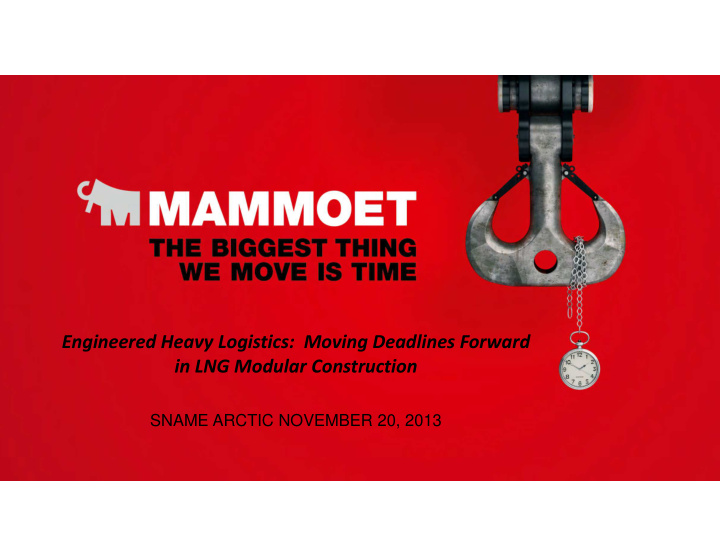



Engineered Heavy Logistics: Moving Deadlines Forward in LNG Modular Construction SNAME ARCTIC NOVEMBER 20, 2013
PRESENTATION CONTENT 1. Modularization 2. Engineered Heavy Logistics 3. LNG: Australia to British Columbia 4. Lessons Learned 5. Questions 2
SAFETY MOMENT The Mammoet Minute, only six steps in 60 seconds: – Stop – Think – Look around – Assess the Risk – Take Action – Start your task. 3
4 4
WHY MODULARIZATION? • Limited / strained labor force • Limited workforce accommodation • Limited equipment availability • Harsh environment • Limited plot plan area or greenfield development • Restricted geographic location • Environmentally sensitive • Limited time window 5
ENGINEERED HEAVY LOGISTICS 6 6
7
HOW DOES MODULARIZATION SAVE TIME? 8
WHAT MUST BE CONSIDERED BEFORE WE START TO DESIGN MODULES? 9
WHERE WILL THE MODULES BE FABRICATED? 10
AVAILABILITY OF SUITABLE VESSELS 11
INCORPORATING TRANSPORTATION LOADS IN THE DESIGN OF STRUCTURAL STEEL 12
WHAT SIZE OF MODULES CAN BE REALISTICALLY MOVED? 13
INFRASTRUCTURE LIMITATIONS 14
INFRASTRUCTURE LIMITATIONS 15
16
• Limited / strained local labor force • Access to offshore labor force • Remote / “Harsh” environment • Limited plot area / green field development • Environmentally sensitive • Schedule / cost / safety driven projects 17
LNG MODULAR CONSTRUCTION EXPERIENCE Australia: • Darwin LNG • Gorgon LNG • Ichtys LNG Project • Wheatstone • Woodside LNG Train • Woodside Pluto 18
GORGON PROJECT SCOPE OVERVIEW • 56 Modules (MOD) (SPMT) • Range between 450 – 6500 Tonnes • 9 Column's (PDR) (CRANE) • Range between 138 and 1112 Tonnes • 233 Pipe racks (PAR) (SPMT / CRANE) • Range between 12 and 1500 Tonnes • 32 Substation Buildings (CRANE) • 6 Compressor/Turbine lines (CRANE) • 6 Waste Heat Recovery stacks (SPMT/CRANE) • Additional scope : 140+ small pre-assembled structures (Load-out / Load-in AMC Yard Perth) <100Te 19
MOF JETTY / MOF GORGON SITE OVERVIEW CAUSEWAY LNG PLANT FLARE 20
GORGON SITE OVERVIEW 21
SITE PLAN (EXCL. FLARE + MOF) 22
ROLL ON / ROLL OFF 23
TRAIN 1 LNG MODULE (6000+ TE) 24
2 ND LNG TRAIN MODULE (TAJB) 25
AMINE ABSORBER (1112 TE) 26
AMINE ABSORBER RIGGING 27
AMINE ABSORBER LIFT 28
PIPE-RACK TRANSPORT IMPRESSION 29
PIPE-RACK TRANSPORT IMPRESSION 30
INSTALLATION CHALLENGES Tight operations Constant changing site conditions Unexpected additional scope Maintaining delivery schedule Shortage of laydown area Large amount of auxiliary equipment 31
LESSONS LEARNED 32
LESSONS LEARNED 1. 100% engineering completion before start of fabrication • Failure to accomplish this will result in potential for significant increase in on site direct / indirect hours 33
LESSONS LEARNED 2. Early involvement of EHL (Engineered Heavy Logistics) • Including an EHL as an overall advisor will optimise the logistics chain in time and money • Optimization of sea fastening, grillage and lashing equipment thru smart engineering • Determine logistics envelop • Highlight bottleneck for logistics strategy • Standardize lifting and transport supports as much as possible for all items • An EHL approaches design from an optimized construction point of view. Historically, in the offshore industry, modularisation has been a lump sum based execution strategy. Therefore, the EHL will view onshore projects from the same mindset. 34
LESSONS LEARNED 3. Select construction strategy at early stage • Build high modules (only SPMT) • Build lower modules (SPMT with cranes) • Define maximum weights to optimize crane use (i.e. single crane for all lifts) • Including legs on the modules allows for flexible placement and storage 35
LESSONS LEARNED 4. Interface management • Strong technical and operational experience for integration of marine and land contractors • Involved parties: MWS, marine contractor, customs, Client, site contractor, stevedores, longshoreman, engineering design contractor, sea fastening fabricator, etc. • Clearly understand responsibilities of all parties prior to operations 36
LESSONS LEARNED 5. Management of the unexpected • We do not live in an ideal world. Always have a plan B (and perhaps even C) • Prepare for receiving cargo day or night • Sufficient support equipment (module stands, load spreader mats and miscellaneous equipment) • Where possible, have 2 discharge locations to reduce potential for expensive demurrage for transport vessel and equipment 37
LESSONS LEARNED 6. Module Alignment • Module Alignment requires strong spotters to ensure proper positioning and no damage to piperacks and equipment • There will be misalignment within the module blocks. Differences in temperatures will make every pipe extend or retrack. • Make sure you can compensate misalignment of this piping by using sleeves, or spacers and adequate measuring and shimming equipment is available • Understand boundaries of approval with all parties 38
LESSONS LEARNED 7. Shipping / Importation of Equipment • In environmentally sensitive areas special preparations (cleaning of equipment, customs paperwork, inspections) are required • Custom clearance for modules can be significant scheduling 8. Local Contractors • Well versed in local labor regulations and requirements • Experience with camp based work 9. Communication 39
MOVING DEADLINES FORWARD 40 40
Recommend
More recommend